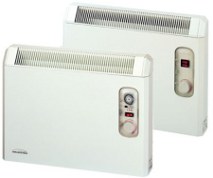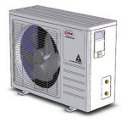- Electric
- Oil
- Gas cylinders/tanks
- Solid fuel such as logs/coal
- Solar
Here we will focus on electric heating.
Convection Heaters

|
Convection heaters are cheap to buy but not cheap to run. They provide heat quickly but also cool down quickly. Some variant have oil in them which is heated so that it holds the heat longer - more like a storage heaters. A typical convection radiator costs about £ 50 to buy so they are cheap to install heating throughout a building. A typical radiator is about 2kw. Standard rate electricity is around 15p per kwh (1kW for 1 hour)so having the radiator on for 1 hour will cost 30p. If a house has 7 of these radiators on for 24 hours in a cold winter, it will cost £50 per day to have these on constantly. Compare this with gas heating which would be about 5p per kwh and a modern combi boiler at 95% efficiency, will cost £17 per day. However a gas boiler installation will cost about £ 3000 to install compared to around £700 for the convection radiators. Assuming 30 days per year where the heating is constantly on and 90 days per year where it is on 25% of the time, it will cost £ 3,800 for the convection heating per year and £ 890 for the gas heating per year. The gas heating would be cheaper after the first year when the install costs are taken into consideration. If you are on an economy 7 tarriff, the night tarriff will be about 5p per kwh from midnight to 7am and 20p for the daytime rates. The blended rate will be 15.6p per kwh so will actually be higher than using a standard tarriff. |

|
Underfloor heating is a variant on convection heating. The heating elements are under the floor. Usually they are rated at 150W per m2 so a 16m2 room would be 2.4kW. Costs are around £34 per m2 so a 16m2 room would be £550. They are therefore more expensive to install than standard convection heaters but are comparable in costs to storage heaters. An advantage of underfloor heating is that the heat is more evenly spread and heat rises meaning it is possible to achieve the same level of comfort whilst being a couple of degrees cooler. The floor surface needs to be insulated which will improve the energy efficiency of the building anyway however insulation adds to the installation cost. If the floor is stone, there is some heat storage however the large surface area will mean the heat quickly dissipates. |
Storage Heaters

|
Storage heaters are similar to convection heaters in appearance but operate in a different way. Storage heaters are very heavy as they are filled with bricks. The bricks are heated to store the heat. The idea is that the storage heaters are on overnight using cheap rate electricity on Economy 7 to heat the bricks which then retain the heat during the day and allow the heat to be released during the day. The problem with them is they will release heat during the day when people are at work and often have released the heat by the evening when temperatures are falling. This means expensive day time electricity has to be used to heat the storage heaters.
Usually they have a higher power consumption than convection radiators so they will have stored more energy during the cheap night period and therefore should be cheaper to run than convection heaters. Storage heaters are more expensive to buy than convection heaters. A 3.4kW unit will be about £ 400 so returning to the example above, the installation cost will be around £3000. In theory they should be cheaper to run than convection heaters as they store cheap rate heat and release it during peak rate periods. A 3.4kw storage heater should be able to charge upto 23.8kw in a 7 hour off-peak period. This means if it is dissipating 2kw per hour outside the off-peak window, it would give off 2kw of heat from 7am to about 7pm. Note however these discharges are based on 20oC target and also assume there is no heat demand (or heat losses) during the night period. The unit will be less effective at heating a room, the cooler it gets. Wet radiator systems typically have temperatures of 50-65oC to achieve a room temperature of 20oC. A large storage heater will have 112kg of bricks in them. The specific heat capacity of brick is 0.84 so it takes roughly 30 seconds of 3.4kw to heat these blocks by 1oC. We havent been able to find information on how hot the bricks are heated to but for safety reasons we believe it is unlikely to be higher than 250oC so the likely stored capacity is therefore 6kwh (3 hours worth of 2kw output). |
Wet Electric

|
A recent innovation in the world of electric heating is electric wet systems. These are similar to the traditional wet water filled radiator systems you get with gas systems. Instead of having a gas boiler, there is an electric boiler - similar to a kettle, which heats the water up in the system. Many of these systems are instanteous, where the boiler heats the water when there is heating demand. In terms of energy consumption, there is absolutely nothing to gain from having a wet system compared to convection heating. The energy has to come from somewhere - in fact the wet systems probably use slightly more energy than convection heating. The water once heated does store the heat but it doesnt store the heat for long periods.
However if a storage cylinder is added to this type of system, it is possible to store large ammounts of energy with relatively little loss, which can be released in a controlled manner. The downside is the storage cylinder will be large. |
| The picture shows a small cylinder which is mainly for hot water rather than central heating. If a large 450 litre storage tank is used, cheap rate electricity can be used to heat the tank. The tank can store very hot water - it is realistic to heat the water to 85oC which is far hotter than the temperature circulating through radiators. To heat this overnight using cheap rate electricity (from 4oC) will cost £2 (in practice the tank will not fall to 4oC but say 30oC so £1.36) It is feasible to release 25 kwh of energy from the tank when there is demand based on the radiators falling to 40oC. In the scenario we used above, we had 7 rooms of 2kW = 14 kW sothe system can provide 2 hours of heat at full demand. A reasonably well insultated house should need about 18,000 kwh per year to heat - the above example is very close to this. So for the 30 days where heating is always on, then the stored system will avoid 2 hours worth of peak rate electricity and increase off-peak consumption by 2 hours (cant get energy for nothing), so 15hours at peak rate. For the 90 days where there is 25% demand, there would be 2.25 hours of peak rate demand. This will save £500 per year compared to the convection heating.The installation will be around £3,000 to install. A larger tank would increase the savings but a 1,000 litre tank would be a large object in a flat. It could be realistic to have a 1,000 litre storage talk in a house in the country. Doubling the size of the tank would result in storage of £1,000 worth of energy per year compared to the convection heater scenario (£2,800 cost per year). It would mean no use of peak rate priced energy other than for the 30 day heavy demand period. Having a tank means it would be realistic to use other heat sources such as log burning stoves with back boilers to avoid the use of electric heating. If you were lucky enough to have the space for a 2,000 litre tank, the savings would be £2,000 per year compared to convection heating however the installation costs rise to around £5,000. For 18,000 kwh, gas would cost £1,260 per year (around £1,500 once boiler inefficiencies are considered) and this system £1,800 so it starting to be competitive. |

|
Heat Pumps

|
Heat pumps are a kind of solar heating type system. They are essentially fridges working in reverse. They extract heat from surroundings, for example heat energy in a lake, ground or even the air. They can be pretty expensive to install and often require land. Ground source heat pumps require land and pipes need to be buried in the garden to extract heat from the soil. An alternative ground source requires drilling of deep bore holes vertically rather than laying lots of pipework in the ground. An air source heat pump can extract heat from the air - this is possible even when it is cold outside because there is still heat in the air relative to the refridgerant in the the system. Heat pumps give the appearance of getting energy for nothing. This is not true. These systems require electricity in order to extract the heat however it can be a very cost effective way of obtaining heat. Taking an air source heat pump for example, in order for it to give 16 kw of heat output, it will need about 4kw of electricity. Assuming standard rate electricity of 15p / kwh, the buy 1, get 3 free means the effective cost per kwh is 3.75p/kwh which is very cost effective and comparable to gas. The downside is the cost. Air source heat pumps do not have such high installation costs however they are less efficient than ground source heat pumps and the output is less predictable with outdoor temperature changes. All heat pumps will require outdoor space for the condensor units - similar to those found on air conditioning systems. The air source heat pump "boiler" for a 16kW system will be around £6,500 and then there is the cost of the plumbing which could easily be another £ 2,000. The output temperatures from these boilers are lower than standard boilers - typically 50-55oC compared to a gas boiler 60-90oC, so they need oversized radiators or underfloor heating to warm a house to the same level as gas. Unless it is a new build or a major refurbishment, doing this is unlikely to be cost effective. Ground source heat pumps can typically cost £ 20,000 for the outdoor plumbing. It is possible to use heat pumps with thermal stores. For example the heat pump can raise the temperature of a thermal store to 50oC using off-peak electricity (yielding an incredibily low effective cost of 1.25p/kwh !!) and then use other sources such as wood burning stoves or electric boiler heating to heat the store to higher temperatures. |